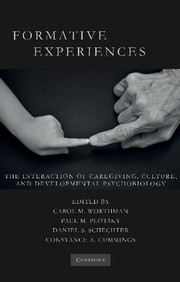Book contents
- Frontmatter
- Contents
- List of Figures
- List of Tables
- List of Contributors
- Foreword by Robert Sapolsky
- Preface
- List of Abbreviations
- Introduction
- SECTION ONE HISTORICAL, CROSS-CULTURAL, AND DEVELOPMENTAL SCIENCE PERSPECTIVES
- SECTION TWO HOW EXPERIENCE INTERACTS WITH BIOLOGICAL DEVELOPMENT
- SECTION THREE FORMATIVE RELATIONSHIPS WITHIN AND ACROSS GENERATIONS
- SECTION FOUR SOCIAL AND CULTURAL CONTEXTS OF CHILDHOOD DEVELOPMENT – NORMATIVE SETTINGS, PRACTICES, AND CONSEQUENCES
- SECTION FIVE FEAR, FUN, AND THE BOUNDARIES OF SOCIAL EXPERIENCE
- SECTION SIX PUBLIC HEALTH, EDUCATION, AND POLICY IMPLICATIONS
- 19 Translations from Human Development to Public Policy
- 20 Global Perspectives on the Well-Being of Children
- 21 Response to: Global Perspectives on the Well-Being of Children
- Index
- References
19 - Translations from Human Development to Public Policy
Published online by Cambridge University Press: 26 May 2010
- Frontmatter
- Contents
- List of Figures
- List of Tables
- List of Contributors
- Foreword by Robert Sapolsky
- Preface
- List of Abbreviations
- Introduction
- SECTION ONE HISTORICAL, CROSS-CULTURAL, AND DEVELOPMENTAL SCIENCE PERSPECTIVES
- SECTION TWO HOW EXPERIENCE INTERACTS WITH BIOLOGICAL DEVELOPMENT
- SECTION THREE FORMATIVE RELATIONSHIPS WITHIN AND ACROSS GENERATIONS
- SECTION FOUR SOCIAL AND CULTURAL CONTEXTS OF CHILDHOOD DEVELOPMENT – NORMATIVE SETTINGS, PRACTICES, AND CONSEQUENCES
- SECTION FIVE FEAR, FUN, AND THE BOUNDARIES OF SOCIAL EXPERIENCE
- SECTION SIX PUBLIC HEALTH, EDUCATION, AND POLICY IMPLICATIONS
- 19 Translations from Human Development to Public Policy
- 20 Global Perspectives on the Well-Being of Children
- 21 Response to: Global Perspectives on the Well-Being of Children
- Index
- References
Summary
Early childhood development (ECD) is receiving increased attention and scrutiny as policy makers attempt to respond to several historical, economic, scientific, and cultural changes that are transforming our understanding of the importance of the early years. This chapter tracks the evolution of our understanding about ECD and discusses the type of policy changes required to ensure that young children have the opportunity for optimal development. We propose a policy transformation framework to help guide the evolution of the current fragmented model of ECD services to a more responsive, comprehensive, integrated, and high performing early childhood system for the twenty-first century.
OVERVIEW
Our analysis begins with a discussion of the historical, political, and cultural contexts that influence ECD policies, practices, and programs, with a special emphasis on the transactional relationship between cultural norms and policy development, decision-making, and implementation. We then discuss the evolution of early childhood policy in the United States, focusing specifically on outcomes that are reflected in current measures of children's health, development, and well-being and what we know about the performance of services, programs, and policies currently in place to improve child health and developmental outcomes. We introduce the Life Course Health Development framework to link theories of social, cognitive, and emotional development with clinical and policy-oriented approaches toward optimizing health development outcomes. The Life Course Health Development framework also provides the basis for a more integrated approach to ECD, one that is more in tune with the human capital development orientation of a post-industrial society.
- Type
- Chapter
- Information
- Formative ExperiencesThe Interaction of Caregiving, Culture, and Developmental Psychobiology, pp. 505 - 530Publisher: Cambridge University PressPrint publication year: 2010



